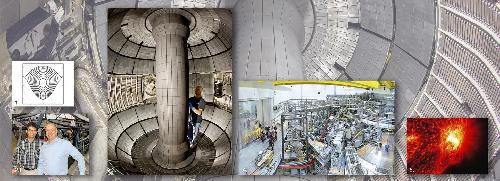From launching the most powerful spherical tokamak on Earth to discovering a mechanism that halts solar eruptions, scientists at the U.S. Department of Energy's Princeton Plasma Physics Laboratory advanced the boundaries of clean energy and plasma science research in 2015. Here, in no particular order, are our picks for the Top-5 developments of the year:
1. Starting up the National Spherical Torus Experiment-Upgrade (NSTX-U)
PPPL completed construction of the NSTX-U, the Laboratory's flagship fusion facility, doubling its heating and magnetic power and making it the most powerful spherical tokamak in the world. The machine is shaped like a cored apple, unlike conventional donut-shaped fusion facilities, and creates high plasma pressure with relatively low magnetic fields -- a highly cost-effective feature since magnetic fields are expensive to produce. The upgrade creates a flexible research platform that will enable physicists to directly address some of fusion's most outstanding puzzles.
 From top left: 1.Magnetic island geometry revealing the mechanism for the density limit. (Reprinted with permission from Phys. Plasmas 22, 022514 2015); 2.Carlos Paz-Soldan and Raffi Nazikian advanced understanding of the control of heat bursts; 3.interior of the NSTX-U showing the completed center stack; 4.W7-X stellarator in Greifswald, Germany; 5.solar flare at the peak of the cycle in October, 2014, with no observed eruptions. Background: umbrella view of the interior of the NSTX-U. Credit: Elle Starkman/PPPL; Lisa Petrillo/GA for Carlos Paz-Soldan and Raffi Nazikian
From top left: 1.Magnetic island geometry revealing the mechanism for the density limit. (Reprinted with permission from Phys. Plasmas 22, 022514 2015); 2.Carlos Paz-Soldan and Raffi Nazikian advanced understanding of the control of heat bursts; 3.interior of the NSTX-U showing the completed center stack; 4.W7-X stellarator in Greifswald, Germany; 5.solar flare at the peak of the cycle in October, 2014, with no observed eruptions. Background: umbrella view of the interior of the NSTX-U. Credit: Elle Starkman/PPPL; Lisa Petrillo/GA for Carlos Paz-Soldan and Raffi Nazikian
2. Discovering a mechanism that halts solar eruptions
Solar eruptions are massive explosions of plasma and radiation from the sun that can be deadly for space travelers and can disrupt cell phone service and other crucial functions when they collide with the magnetic field that surrounds Earth. Researchers working on the Magnetic Reconnection Experiment (MRX), the world's premier device for studying the convergence and separation of magnetic fields in plasma, have discovered a previously unknown mechanism that causes eruptions to fail. The findings could prove highly valuable to NASA, which is eager to know when an eruption is coming and when the start of an outburst is just a false alarm.
3. First plasma on Germany's Wendelstein 7-X
On December 10, 2015, the Wendelstein 7-X (W7-X) stellarator produced its first plasma after 10 years of construction. PPPL, which leads the United States' collaboration in the German project and will conduct research on it, joined the worldwide celebration of the achievement. The Laboratory designed and delivered five barn-door size magnetic coils, together with power supplies, that will help shape the plasma during W7-X experiments. The Lab also designed and installed an X-ray diagnostic system that will collect vital data from the plasma in the machine. Stellarators are fusion facilities that confine plasma in twisty -- or 3D -- magnetic fields, compared with the symmetrical -- or 2D -- fields that tokamaks produce.
4. Enhanced model of the source of the density limit
Physicists have long puzzled over a mystery called the density limit -- a process that causes fusion plasmas to spiral apart when reaching a certain density and keeps tokamaks from operating at peak efficiency. Building on their past research, PPPL scientists have developed a detailed model of the source of this limitation. They've traced the cause to the runaway growth to bubble-like islands that form in the plasma and are cooled by impurities that stray plasma particles kick up from the walls of the surrounding tokamak. Researchers counter this heat loss by pumping fresh heat into the plasma, but even a tiny bit of net cooling in the islands can cause them to grow exponentially and the density limit to be reached. These findings could lead to methods to overcome the barrier.
5. Breakthrough in understanding how to control intense heat bursts
Scientist from General Atomics and PPPL have taken a key step in predicting how to control potentially damaging heat bursts inside a fusion reactor. In experiments on the DIII-D National Fusion Facility that General Atomics operates for the DOE in San Diego, the physicists built upon previous DIII-D research showing that these intense heat bursts -- called edge localized modes (ELMS) -- could be suppressed with tiny magnetic fields. But how these fields worked had been unclear. The new findings reveal that the fields can create two kinds of response, one of which allows heat to leak from the edge of the plasma at just the right rate to avert the heat bursts. The team also identified the changes in the plasma that lead to suppression of the bursts.
source: DOE/Princeton Plasma Physics Laboratory